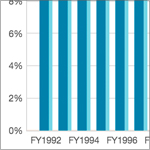Federal Funds Drive Long-term Growth in State Spending
After the Great Recession ended, total spending by state governments hit its highest level as a share of the economy in at least 20 years. Federal funds drove the growth, as spending from states’ own dollars shrank relative to the economy.
These data have been updated. To see the most
recent data and analysis, visit Fiscal 50.
States collectively hit their peak in total spending in fiscal 2010 and 2011, the same years they got their largest doses of temporary economic stimulus aid from the federal government. But federal funds have played a key role in supporting state spending for far longer.
Total state spending—coming from states’ own funds plus the federal dollars they received—grew from 11.9 percent of state personal income in fiscal 1992 to 12.9 percent in fiscal 2011, a 1 percentage point increase. (State personal income is the total amount that residents earned from wages, investments, and other sources and is one measure of a state’s economy.) What drove growth was spending from federal funds. As a share of personal income, state spending from federal funds increased 1.3 percentage points while spending from states’ own sources fell 0.3 points.
In fiscal 2011 Arizona spent less of its own funds than at any time since at least 1961, and Florida’s state-sourced spending was at its lowest level since 1986.
Spending from federal funds was higher as a share of the economy in every state in fiscal 2011 compared with 20 years earlier. Still, despite those increases in federal funds, total spending was down as a share of the economy in 12 states due to declines in their state-sourced spending.
States fell into one of three categories
- In 19 states, spending was up from both state and federal funds. (See blue states on the map.)
- In 19 states, total spending grew with the help of federal funds, even as state-sourced spending decreased. (See brown states.)
- In 12 states, total spending was down, as state-sourced spending fell more than federal funds increased. (See orange states.)
State highlights based on spending as a share of the economy:
- In fiscal 2011 Arizona spent less of its own funds than at any time since at least 1961, and Florida’s state-sourced spending was at its lowest level since 1986.
- In total spending, the biggest increases compared with 20 years ago were in Mississippi (4.7 percentage points) and Vermont (4.6 points), and the biggest decreases were in Alaska (-5.8 points) and Rhode Island (-3.4 points).
- State-sourced spending saw the most growth compared with 20 years ago in Arkansas (1.8 percentage points) and Delaware and Vermont (each 1.6 points), and the biggest declines in Alaska (-9.1 points) and Rhode Island (-4.5 points).
- Spending from federal funds grew the most in New Mexico (4.2 percentage points) and the least in Colorado (0.1 points).
The broad measure of state spending used here captures far more than general fund budgets. State-sourced spending includes all expenditures approved by legislatures, including the annual costs of multiyear commitments, and spending by related units of state government. The measure also includes spending of federal revenue, over which state policymakers may have less control. Because change in state spending as a share of the economy reflects both spending and economic performance, changes in either factor affect the ratio. For example, an increase could mean spending is rising faster than personal income or it could mean spending is stable and the economy is faltering.
Analysis by Brenna Erford and Sarah Babbage












